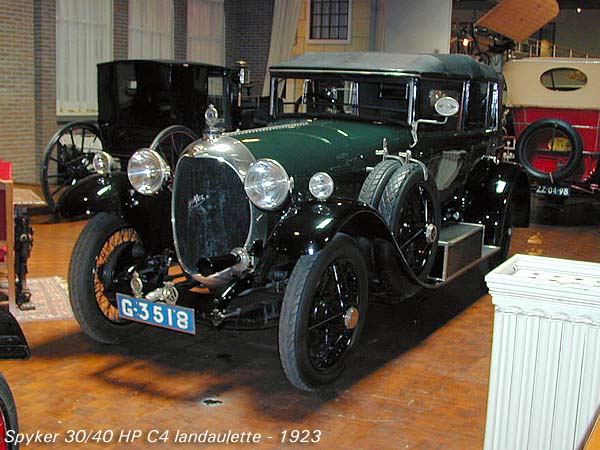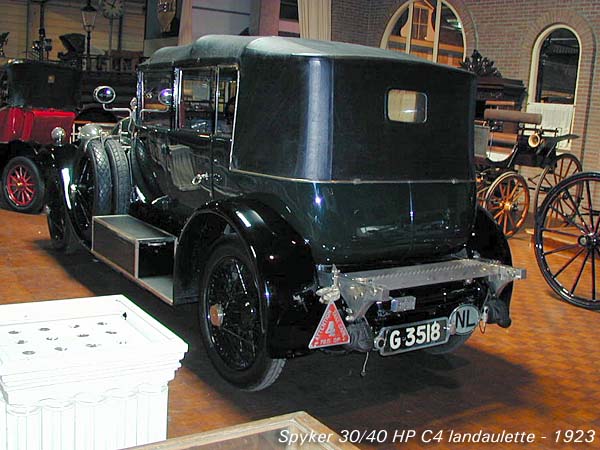|
 The
board of directors of "Trompenburg" were looking for ways to
prove internationally that the Spyker C4 was a top class quality car. Obviously
Rolls Royce cars were more or less the standard for top quality cars and so it
was decided to emulate the famous Rolls Royce Silver Ghost 15,000 miles Glasgow
to London test-drive of 1907. Of course technology had moved on since then and
the local situation in Holland was much different from that in Great Britain, so
Spyker defined a new goal: to break the Rolls Royce record by driving 30,000 km
(18,642 miles) in one Spyker C4 by continuously repeating a route between
Nijmegen and Sittard (in the south, most hilly part of The Netherlands). The
board of directors of "Trompenburg" were looking for ways to
prove internationally that the Spyker C4 was a top class quality car. Obviously
Rolls Royce cars were more or less the standard for top quality cars and so it
was decided to emulate the famous Rolls Royce Silver Ghost 15,000 miles Glasgow
to London test-drive of 1907. Of course technology had moved on since then and
the local situation in Holland was much different from that in Great Britain, so
Spyker defined a new goal: to break the Rolls Royce record by driving 30,000 km
(18,642 miles) in one Spyker C4 by continuously repeating a route between
Nijmegen and Sittard (in the south, most hilly part of The Netherlands).
A team of drivers set out on November 27, 1920 and on the night of January 1,
1921 the goal was achieved. It took 36 days to drive the 30,000 km, and it
attracted a lot of media attention. The Spyker C4 itself was in perfect shape
after this grueling drive, there were only some minor signs of wear and 13 valve
springs were replaced during the drive. After breaking the Rolls Royce record
the car was tributed in Nijmegen and then driven back to the Amsterdam factory
the same day, without any servicing. Nobody doubted the rigidity of the C4's
construction after that.
There was another record attempt with the C4 which found even
more international acclaim: the "double 12-hour" record by S.F. Edge
on the famous Brooklands circuit in England. Renown racing driver Selwyn Edge
had set the average speed record on this track in 1907 by driving an average of
96.5 kph (60 mph) during 24 hours in a Napier. In 1922 he wanted to break this
record since he felt technology had progressed enough to be successful. He
picked a Spyker C4 for his new attempt, a car fitted with streamlined racing
bodywork which already had been used for some other races by the company.
He succeeded by driving an average of 120 kph (74.5 mph) during 24 hours in this
car, no mean feat. Edge was very taken by the quality of the car, and after he
had finished he commented to the British representative of the Spyker company:
"You provided me with a car which was absolutely faultless in the
perfection in which it stood up to the tremendous grueling that a 24 hours run
on Brooklands gives a car at speeds ranging from 73 to 80 odd miles an hour,
hour after hour. Reliability in every way was most remarkable..."
This record-breaking C4 has been reconstructed by the Autotron museum from
original parts in recent years. Only the chassis and the body are not original.
This is the car you see on the first picture of this page. As you can see by the
cars surrounding it, it's huge, about twice the size of a normal contemporary
sports car. It must have been quite a handful to drive at racing speed.
 Although
the C4 was received very well and its qualities were undisputed, its sales
figures were disappointing. The car was far more expensive than people wanted to
pay for it and the market for expensive luxury cars was limited and heavily
competed. It soon became clear that the Spyker one model strategy couldn't
provide for a healthy future for the company. Although
the C4 was received very well and its qualities were undisputed, its sales
figures were disappointing. The car was far more expensive than people wanted to
pay for it and the market for expensive luxury cars was limited and heavily
competed. It soon became clear that the Spyker one model strategy couldn't
provide for a healthy future for the company.
In a desperate attempt to survive Spyker turned to the French Mathis company for
a car in a more affordable market segment. This way the Spyker-Mathis 10 HP
became available in 1921. It was a virtually unaltered Mathis with a Spyker
badge, powered by a 1132 cc 4-cylinder engine and with a 2400 mm wheelbase (the
C4 had 3470 mm). This car was a lot cheaper than the C4: a C4 torpedo costed
about fl. 17,000 where a Spyker-Mathis torpedo could be had for fl. 4,950, only
29% (!) of the C4 price also.
But the world wasn't waiting for a Spyker-Mathis and so it disappeared from the
catalog in 1922.
 By
1921 the financial situation of "Trompenburg" had become very
awkward again. The sales of the C2 truck, the Spyker-Mathis and the C4 all fell
short of expectations. The export to Great Britain was reduced because of new
high import duties and the factory had too much parts in stock, which had been
bought too expensive. In Great Britain the price tag on the C4 was about as high
as that on the Rolls Royce 40/50 HP Silver Ghost and the Hispano Suiza H6, all
very renown and highly coveted motors, and it costed about twice as much as the
comparable Minerva 30 HP from Belgium. This made selling the cars pretty hard
and total profits too low to survive. By
1921 the financial situation of "Trompenburg" had become very
awkward again. The sales of the C2 truck, the Spyker-Mathis and the C4 all fell
short of expectations. The export to Great Britain was reduced because of new
high import duties and the factory had too much parts in stock, which had been
bought too expensive. In Great Britain the price tag on the C4 was about as high
as that on the Rolls Royce 40/50 HP Silver Ghost and the Hispano Suiza H6, all
very renown and highly coveted motors, and it costed about twice as much as the
comparable Minerva 30 HP from Belgium. This made selling the cars pretty hard
and total profits too low to survive.
The C4 chassis was improved in 1921 and four wheel brakes became standard in 1922 (as shown on the car in these pictures). Unfortunately that didn't help its fortunes.
 In
1922 the company had to file for bankruptcy again. The management had been fired
and Spyker's distributor in Britain, Spyker Ltd, acquired the factory. The
company was reorganized and continued in slimmed down form. Prices of the
chassis were lowered considerably and development work was stopped for the main
part. In
1922 the company had to file for bankruptcy again. The management had been fired
and Spyker's distributor in Britain, Spyker Ltd, acquired the factory. The
company was reorganized and continued in slimmed down form. Prices of the
chassis were lowered considerably and development work was stopped for the main
part.
In the years that followed ownership of Spyker changed a few times, but it was
all a matter of slow liquidation and limiting losses. The factory had a large
stock and production of the C4 (and C2 truck) lasted until the parts in stock
had depleted.
This lasted until 1926 when parts and funds had run out. Then the liquidation of
Spyker became definitive, production was stopped and all assets were sold. By
that time the belief in a feasible and profitable car production in The
Netherlands had disappeared and only a general feeling of disappointment
remained.
It's estimated that total Spyker car production up to 1926 lies
somewhere between 1500 and 2000 cars, which isn't much for more than 25 years of
manufacturing. Spykers were always rare cars, exotic but technically advanced
and dependable. Less than 20 complete Spyker cars have remained to this day,
most of them displayed in Dutch museums. In time the frustration over the Spyker
failure in Holland was replaced by admiration for these wonderful cars and the
achievements which were made. More and more the Spyker name became a synonym for
quality over profit and idealistic engineering, values that appeal somehow to
the Dutch.
Instead of being forgotten Spyker became an icon, a name each Dutchman knows
about, regardless of knowledge of cars. As a brand name it had some potential
also, but nobody had thought about using it....
|
